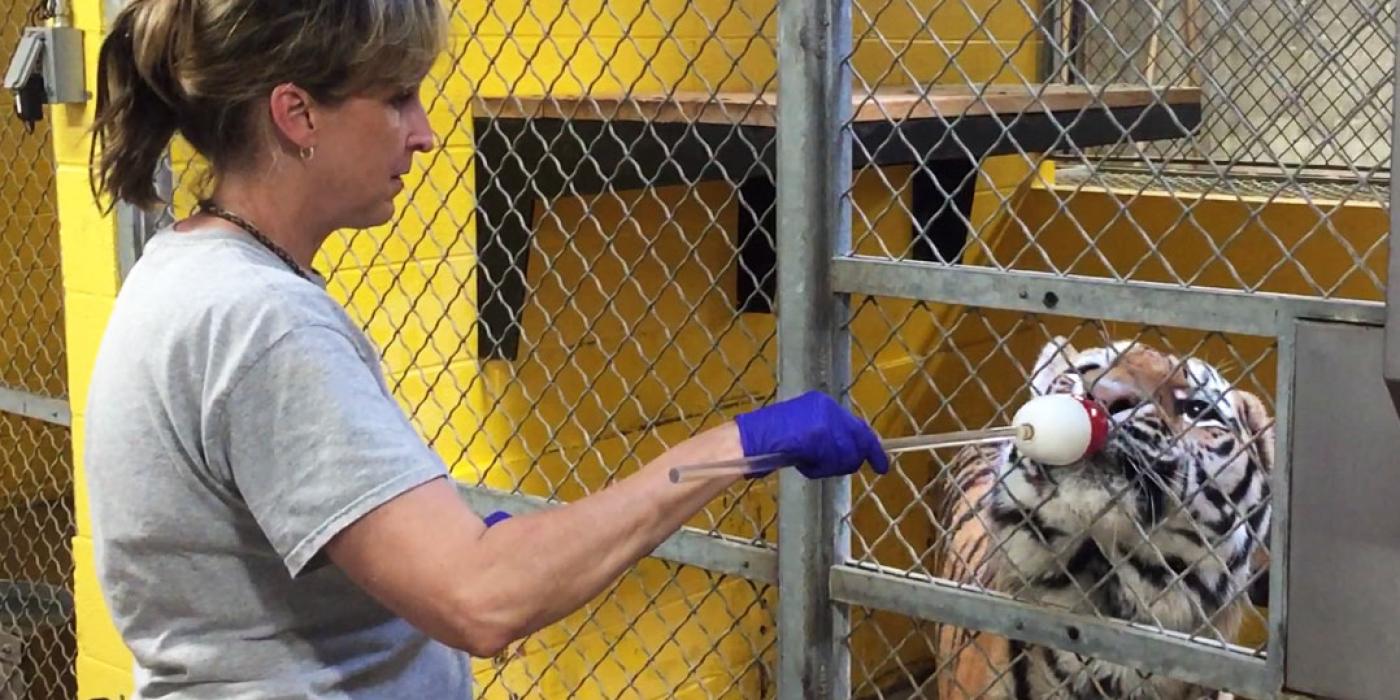Sumatran Tiger Cub Q&A: Dec 17, 2014
Sumatran tiger cubs Bandar and Sukacita are growing up fast and undergoing some big changes at the Great Cats exhibit! At 16 months old, these cubs won't be fully-grown adults for another year or two, but they're already showing maturity and independence. Keepers Marie Magnuson and Dell Guglielmo, along with curator Craig Saffoe, talk about training, separating from mom Damai, and the possibility of new cubs in the latest Q & A.
Now that the tigers are 16 months old, how has their social dynamic changed?
Marie: While Bandar weighs 209 pounds and Sukacita weighs 167 pounds, they are not yet fully adult. Damai and Sukacita are still on exhibit together and have visual access to each other at night. It's likely that when Sukacita starts to go into estrus, Damai will no longer see her as her daughter, but as a rival. At that point we will house them separately (aside from a mom with cubs, tigers are solitary in the wild). Since there is no clear visual clue when tigers reach sexual maturity, Bandar no longer has direct contact with his sister and mother, though he can see his sister at night through a mesh "howdy door." Damai and Bandar occasionally have visual access to each other inside. He appears to be much happier to see her than she is to see him. Any friendliness on her part towards him would indicate that she is starting to cycle again. Cats in the wild usually do not reproduce until they are between 3 to 5 years of age, but in human care we separate them once they begin exhibiting breeding behaviors to prevent inbreeding.
How is Bandar adjusting to being separated from Damai and Sukacita?
Marie: When we first separated the cats, Bandar vocalized quite a bit and called out to his mom and sister. He still has visual access to them through the howdy door, so he's acclimated to being physically apart from them.
Dell: We do our best to mimic a natural separation that would take place in the wild, and at about 6 months to 1 year of age, a male cub would leave mom and be out on his own. We also don't want to risk putting the cats in a situation that could enable physical aggression or risk inbreeding.
What behaviors will you look for in determining when Sukacita and Damai need to be separated?
Marie and Dell: The dynamic in a relationship between cats could happen fast and with little or no warning. We look for any signs of aggression when we're here during the day and keep them separated (but with visual access) at night.
What behaviors are you training? Which behaviors have the cats mastered, and which are still a work in progress?
Marie: While all cats learn the basics such as "target," "sit," and "down," we have been focusing most of our attention on training medical behaviors. Bandar is very self-confident and the best at allowing us to touch his paw pads. This would come in handy if he gets cracks in his pads due to dry, wintery weather. Sukacita is very clever at determining what it is the keeper wants, though she will try and use charm to get the reward instead of following the behavioral cue. We spend the majority of our training time training the tigers to receive injections. Both are making steady progress!
What is next for Bandar and Sukacita as they grow into adulthood?
Dell: The Species Survival Plan (SSP) for Sumatran tigers will make a breeding recommendation for both Bandar and Sukacita. It's likely that they'll remain at the National Zoo for at least another year before moving to another zoo, being paired with mates, and hopefully becoming parents themselves. We will continue to monitor the social interactions between Damai and Sukacita, which will determine the time the two females will remain together during the day.
Will Damai breed again? If so, when?
Craig: At this point in time, it is very difficult to say whether or not Damai will breed again. We must first await a breeding recommendation for Bandar and Sukacita, which could be 1-2 years down the road. Once they've moved on, the SSP will make a recommendation for Damai based on her mean kinship (the amount of relatives she has in the North American population).
What has been the most challenging part of raising tiger cubs?
Marie: Keeping up with them! They grow up fast.
What is the most rewarding part of taking care of these cats?
Marie: Working with them every day and building a relationship of trust.
Dell: Watching them grow and mature into young healthy adults is most rewarding. Mom's done most of the work but our responsibility is to monitor and observe their social dynamics and growth to ensure health.
Related Species:

